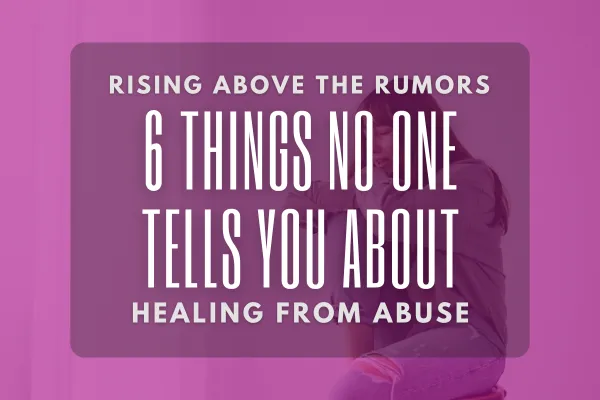BLOG
Through the stories shared here, we hope you find the strength to overcome your obstacles, the courage to embrace your true self, and the motivation to create a life that truly lights you up, inside and out.

Rising Above the Rumors: 6 Things No One Tells You About Healing From Abuse
The path to healing isn't paved with simple truths or easy fixes, and it certainly doesn't resemble the stereotypes often portrayed.

You might be led to believe that strength alone can propel a swift recovery, or that abuse is limited to certain demographics. But at Flight of the Phoenix, we confront these misconceptions head-on. Healing is a deeply personal, often nonlinear journey, and abuse can touch anyone, anywhere.
Join us on this journey—not just to read a blog, but to become part of a community dedicated to empowering one another. Together, we will challenge these myths, discover the truths, and provide mutual support every step of the way.
Welcome to our space, where together we rise, heal, and thrive.
Myth 1: It Only Happens to Certain People
It's a common but dangerous belief that abuse is selective, targeting only certain types of people. This myth perpetuates a "not me, not here" mentality that can lead to a lack of awareness and preparedness, which ultimately endangers everyone.
Abuse does not discriminate—it can affect anyone regardless of age, race, gender, socioeconomic status, or any other demographic marker. By thinking it could never happen to "people like us," individuals may inadvertently overlook signs of abuse in their communities, in their circles, and even in their own homes. This denial can isolate survivors, making them feel like outliers in their own experiences, and can discourage them from seeking help due to a perceived notion that abuse is uncommon in their community.
Moreover, this myth contributes to the stigma surrounding abuse. It suggests that there are "typical" victims and, by extension, "typical" non-victims, reinforcing harmful stereotypes. This stigma can make it extremely challenging for survivors to come forward, as they may fear disbelief, social ostracism, or even blame.
Our team understands that abuse is a universal issue that requires a universal response. We stand ready to support anyone and everyone affected by abuse. Our mission is to foster a community where all feel safe to share their stories and seek the help they need without judgment. We aim to educate and raise awareness that abuse can happen anywhere and to anyone, and by doing so, we can better prevent it and support those who are impacted.
Myth 2: Teaching 'Stranger Danger' Will Keep Your Kids Safe
Many believe that abuse, particularly child sexual abuse, can be prevented simply by taking the right precautions. However, this belief fails to recognize a crucial fact: the majority of child sexual abuse cases involve a perpetrator who is familiar to the child, not a stranger.
Statistics show that about 90% of child sexual abuse victims know their perpetrator in some way (Source: Darkness to Light). This can include family members, family friends, caregivers, coaches, and other trusted adults. These are individuals who often have legitimate reasons to be in close proximity to the child, which can make the abuse harder to detect and prevent, regardless of the precautions taken.
This misunderstanding can create a false sense of security. You might believe that as long as you keep your children away from strangers, you can protect them from harm. Yet, the reality is that abuse more often occurs within the child’s own network, making it essential to broaden our vigilance beyond the stranger-danger narrative.
In our community, we advocate for a more comprehensive approach to prevention. This includes educating parents and children about the signs of grooming and manipulation, which are tactics often used by perpetrators to gain the trust of a child and their family. Creating open lines of communication within families and communities about these realities is vital. It ensures that children know they can speak up about any uncomfortable situations with familiar adults, and parents are better prepared to believe and act on their concerns.
By debunking the myth that taking basic precautions against strangers is enough, we empower communities to protect their children more effectively. Awareness and education are key in building environments where children are safe from abuse, even from those within their circle of trust.
Myth 3: A Few Conversations About Body Safety Are Enough
It’s a widespread belief that a single conversation or a few talks about body safety can sufficiently prepare children to recognize and report abuse. However, the reality is that educating children about their bodies and safety needs to be an ongoing conversation that evolves as they grow.
Understanding and using the correct anatomical terms for their private parts is a critical first step. It empowers children with the language to clearly describe any inappropriate actions or discomfort they might experience. However, relying solely on this initial education without continuous reinforcement can leave gaps in a child's understanding and ability to act when it matters.
Regular discussions about body safety are crucial. These conversations should include topics like understanding and respecting personal boundaries, recognizing safe and unsafe touch, and knowing whom to approach for help if they feel unsafe or uncomfortable. Each discussion offers an opportunity to reinforce these concepts and ensure that they are understood and remembered.
Moreover, as children grow, their comprehension and the situations they encounter become more complex. What is appropriate for a preschooler differs significantly from the information a preteen or teenager might need. Regularly revisiting these topics ensures that children have age-appropriate information and feel confident in their knowledge and ability to protect themselves.
Our advocacy for proactive engagement in children’s education about body safety includes creating an open environment where children feel safe to ask questions and express concerns at any time. Making body safety an ongoing topic of conversation helps build a foundation of trust and openness, which is vital for children to feel supported and understood.
Myth 4: Survivors Must Look and Act a Certain Way
The stereotype of the "ideal" survivor, often perpetuated by movies and media, is not only unrealistic but also harmful. This depiction usually involves someone who appears perpetually strong, resilient, and somehow even polished through the ordeal—emerging unscathed. However, the truth is that the impact of abuse is far-reaching and manifests differently in everyone.
Survivors of abuse encompass a broad spectrum of personalities, backgrounds, and ways of coping. Some may appear strong and unbreakable, ready to share their stories and advocate for others. Others might be more introspective, dealing with their trauma quietly and preferring privacy. There are also survivors who oscillate between these responses, feeling empowered one day and overwhelmed the next (like yours truly).
Moreover, the external appearance of strength or fragility can be misleading.
Emotional resilience doesn’t always come with a loud voice; it’s often found in the quiet determination to continue everyday life despite inner turmoil.
It's crucial to acknowledge that each survivor's response is shaped by numerous factors, including personality, support systems, cultural background, and the nature of their experiences.
Validating the wide range of survivor responses is essential. By expecting a certain type of behavior or recovery path, we risk invalidating the experiences of those who don’t fit the mold. This can lead to survivors feeling misunderstood or isolated, complicating their healing journeys.
We emphasize that there is no “correct” way to survive. Each person’s healing process is valid and deserves recognition and support. It’s important to challenge these stereotypes and encourage a more nuanced understanding of what survival can look like. Only by embracing the diversity of survivor experiences can we provide truly inclusive and effective support.
Myth 5: There's a Timeline for Recovery

A common misconception is that healing from abuse should follow a predictable timeline—like ticking off days on a calendar until you're "healed." But in reality, recovery doesn't work like that. It's a deeply personal journey, unique to each individual. It involves navigating complex emotions and overcoming numerous challenges, which do not adhere to any set schedule. Some days, you may feel strong and unbreakable, filled with hope and progress. Other days, you might encounter setbacks that make the wounds feel fresh again. Both are integral to the healing process.
Healing is not about checking off boxes by certain deadlines. Rather, it's about giving yourself the grace to heal at your own pace, without the pressure of societal expectations or arbitrary timelines. It’s important to recognize and accept that healing takes as long as it needs to—whether that’s months, years, or longer. There is no standard duration for healing, and no one should feel pressured to "get over it" by a certain time.
Myth 6: You Can’t Build a Healthy Life After Abuse
Perhaps one of the most destructive myths is that life after abuse is forever tainted. We fiercely challenge that notion. This myth can be one of the most discouraging and damaging beliefs for survivors to confront. It implies that the scars left by abuse are permanent barriers to happiness and functionality in life. However, this is far from the truth.
Recovery from abuse is undoubtedly challenging and can be a long-term process, but with the right kind of support and resources, it is entirely possible to not only regain a sense of normalcy but also to flourish. Thriving after abuse involves a combination of professional help, such as counseling or therapy, and supportive personal relationships. Counseling can provide survivors with tools to process their experiences and develop coping strategies. Meanwhile, support groups or communities can offer understanding and encouragement from others who have faced similar challenges.
Moreover, holistic healing modalities like yoga, meditation, and art therapy have proven beneficial in restoring mental, physical, and emotional balance. These practices help in grounding survivors, reducing anxiety and depression, and enhancing overall well-being. They empower individuals by reconnecting them with their bodies and minds, fostering a sense of control and peace.
Education and career advancement are also critical components of rebuilding life after abuse. Many survivors find new purpose through their careers or advocacy work, which not only provides a means of independence and financial security but also helps in reshaping their identity beyond being a survivor.
It’s important to challenge the narrative that life after abuse is permanently impaired. Countless survivors have not only rebuilt their lives but have also become advocates, leaders, and inspirers in various fields. They demonstrate that while the impact of abuse is profound, it does not define one's future.
The truth is, every survivor has the potential to create a vibrant and successful life post-abuse. With the right support, resources, and community, survivors can not only recover but also thrive. Through counseling, holistic healing modalities, and a supportive community, a new, empowered chapter of life isn't just a possibility—it's a reality.
In debunking these myths, we aim to shed light on the truth of surviving abuse. It's tough, messy, and complicated, but also filled with moments of profound strength and triumph. We are committed to walking alongside you every step of the way.
So, what’s next? If you or someone you know is navigating this challenging journey, reach out. Our doors are always open, and our community is ready to welcome you with open arms. Together, we can rise from the ashes, informed, empowered, and united.
For more resources, visit our website, and remember, your story matters, your pain is valid, and your healing is on the horizon. Join us, and let’s transform the narrative from surviving to thriving.
Because here, we rise together. Let’s keep the conversation going. Share this post, engage with us on social media, and become a part of a movement that's reshaping the future—one truth at a time.
© 2024 Flight of the Phoenix: A Women's Empowerment Collective - All Rights Reserved.


